
See the Future of High Adventure
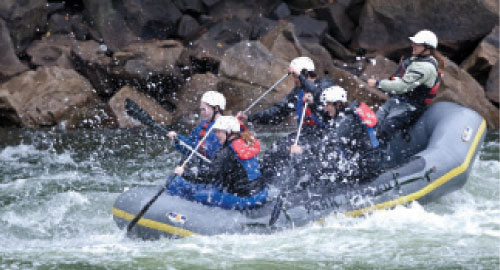 The West Virginia location offers opportunities not found at the other high-adventure bases, such as rafting down the New River Gorge canyon. |
Call it the flip side of success.
Scouting’s three high-adventure camps—Philmont Scout Ranch, Northern Tier National High Adventure Program, and Florida National High Adventure Sea Base—offer thrilling outdoor activities and valuable training to more than 50,000 young people annually.
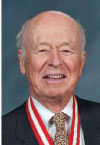 Stephen D. Bechtel Jr. |
But the camps are so popular that another 20,000 Scouts are wait-listed each year, unable to attend. That’s why BSA leaders have been seeking the perfect location for another high-adventure base that would offer a new range of activities. And after spending 18 months considering 80 proposals from 28 states, they have found just the spot on more than 10,600 acres of rugged beauty in the New River Gorge area of Fayette County, W.Va.
 Rappelling will thrill Scouts at The Summit: Bechtel Family National Scout Reserve. |
The new adventure base, which will be called The Summit: Bechtel Family National Scout Reserve, is made possible in part by a $50 million contribution to the project from the Stephen D. Bechtel Jr. family. The Bechtels have a strong Scouting tradition. Stephen D. Bechtel Jr. became an Eagle Scout in 1940, and has been awarded the Silver Buffalo Award and the Distinguished Eagle Scout Award. His uncle, Kenneth Bechtel, served as national president of the Boy Scouts from 1956-1959.
The West Virginia camp, located in the Glen Jean-Mount Hope area, will offer whitewater rafting, rappelling, mountain biking, hiking, and other outdoor sports. After obtaining the necessary permits, the BSA will start construction in spring of this year. Officials expect the camp to open in summer of 2013.
The new site also will be the permanent home for the National Scout Jamboree.
The BSA envisions a few buildings on the property, but the aim is to make a minimal footprint on the area so “the great outdoors can speak to our kids,” says Jack D. Furst, project chairman and a member of the BSA national board. “We have a high-adventure dream that we’re pursuing in West Virginia.”
State and Fayette County officials also say they’re pumped up about the coming partnership with the BSA, which could create as many as 80 full-time jobs.
Chief Scout Executive Bob Mazzuca says: “Thanks to the generosity of the Stephen D. Bechtel Jr. Foundation, the development of The Summit: Bechtel Family National Scout Reserve will be a source of fun, adventure, and discovery for hundreds of thousands of Scouts and leaders for generations to come.”
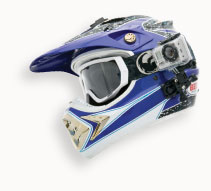 Hail the Conquering Hero
Hail the Conquering Hero
What are the awesome-est, bad-est outdoor adventure-seekers wearing this season?
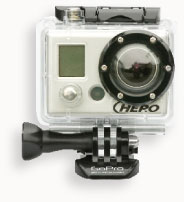 The new HD Hero camera from GoPro, that’s what. It’s the world’s first 1080p HD wearable camera, and it’s just what any skier, surfer, backpacker, or mountain biker needs to capture those “No way!” moments.
The new HD Hero camera from GoPro, that’s what. It’s the world’s first 1080p HD wearable camera, and it’s just what any skier, surfer, backpacker, or mountain biker needs to capture those “No way!” moments.
With the Hero, you’ll soar, roll, or dodge the moguls while shooting HD video at 30 and 60 frames per second, capturing wide-angle shots with ease. An optional wireless microphone and remote will add pro-quality sound in the most rugged environment. The rechargeable lithium battery is good for about 2.5 hours, so, depending on the activity, you might wear out before the camera does.
And you want versatile? Choose from an array of accessories that will attach the Hero to bikes, surfboards, and, of course, your own body. Cap it off by attaching the camera to a big-screen TV and tell your friends, “You won’t believe what happens next!” $299, goprocamera.com.
Get the family to Philmont
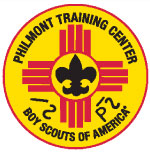 “Are we there yet? Are we there yet?”
“Are we there yet? Are we there yet?”
Mom and Dad may hear those familiar cries this summer, but the destination will be well worth it. Yes, it’s time to make plans for bringing the family to the Philmont Training Center.
While volunteer and professional Scouters and junior leaders tune up with the latest leadership techniques, family members of any age can enjoy exciting and educational programs during the six-day stay.
Fees include conference and program materials, meals, and lodging. They are: conference participants, $470; spouse, $340; children 14-20, $285; ages 6-13, $225; ages 5 and under, $180; Mountain Trek, $345; NAYLE (National Advanced Youth Leadership Experience), $355.
One big change from last year: Participants no longer have to be approved by a local council. See the schedule and get more info at philmonttrainingcenter.org; send questions to trainingcenter@philmontscountranch.org.
What's New?
Scouting’s 100-year history has been marked by many changes in merit badges. Such badges as Cement Work, Farm Layout and Building Arrangements, and Interpreting bowed out long ago, while Climbing, Disabilities Awareness, and Nuclear Science have been added since the 1990s.
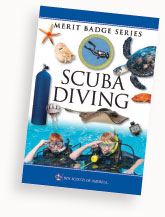 Now some new badges are coming. Scuba made its splash in December, and requirements are being developed for four more merit badges, all of which have been approved. Here they are along with the time they are expected to debut:
Now some new badges are coming. Scuba made its splash in December, and requirements are being developed for four more merit badges, all of which have been approved. Here they are along with the time they are expected to debut:
- Inventing, first quarter 2010.
- Geocaching, second quarter 2010.
- Scouting Heritage, second quarter 2010.
- Robotics, by end of 2010.
Cub Scouts get some new advancement opportunities, as well. It’s been 10 years since the BSA has revised its Academics and Sports belt loops and pins, but the wait is over as 13 new ones are on the way:
Sports:
- Hiking
- Hockey
- Horseback Riding
- Kickball
- Skateboarding
Academics:
- Disabilities Awareness
- Family Travel
- Good Manners
- Nutrition
- Pet Care
- Photography
- Reading and Writing
- Video Games
Making Magic at the 2010 Jamboree
Fans of the old (and new) “Star Trek” franchise know that Captain Kirk and the Enterprise are always ready “to boldly go where no man has gone before.”
 Jim Kirk |
Well, meet another “Captain Kirk” with his own vital enterprise: to make the 2010 National Scout Jamboree an unforgettable spectacle for more than 65,000 Scouts and others who will attend the event at Fort A. P. Hill, Va., in July. And don’t forget another million or so who will watch a broadcast of the event at various locations across the country.
This Captain Kirk, as his friends and coworkers call him, is Jim Kirk, president of Dallas-based CorporateMagic Inc., which produces high-impact events for large corporations such as Jaguar and IBM. The company also cooked up the “wow”-inducing opening ceremony for the new Dallas Cowboys Stadium and will conjure plenty of fireworks for the 2011 Super Bowl. They do it all: music, special effects, video, staging, audience involvement, and more.
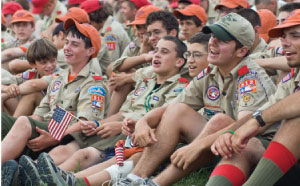 CorporateMagic bills itself as a “messaging architects” company. In the case of Scouting, Kirk says, there’s no mistaking the image he’ll be projecting to the world—the same solid values he encountered as a young Scout in Topeka, Kan.
CorporateMagic bills itself as a “messaging architects” company. In the case of Scouting, Kirk says, there’s no mistaking the image he’ll be projecting to the world—the same solid values he encountered as a young Scout in Topeka, Kan.
“Scouting teaches leadership skills, respect, and an attitude of picking yourself up by your bootstraps and making things happen,” Kirk says. “That’s something few organizations do today.”
A CorporateMagic event always appeals to both the intellect and the emotions, Kirk says, combining high-tech whiz-bangery with a solid foundation of Big Ideas. “We want to reach people both emotionally and intellectually,” he says. “The emotional part is the power that grabs people’s attention, opens their minds, and makes them willing to listen and participate.”
Translation: Those in attendance will learn plenty about Scouting’s 100 years, but don’t expect a half-hour monologue on the life of Lord Robert Baden-Powell.
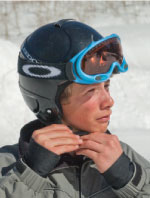 Use, Don't Abuse, your head
Use, Don't Abuse, your head
Here’s a timely head’s up that will keep your boys safer when they take part in this season’s winter-sports activities.
The BSA has clarified requirements in a new rule about gear. “Appropriate personal protective equipment is required for all activities. This includes the recommended use of helmets for all participants engaged in winter sports such as sledding…. The use of helmets is required for the following activities: downhill skiing, snowboarding, and operation of snowmobiles (full-face helmets).”
Also, a reminder: Whenever units engage in winter sports, they should use only designated areas where rocks, tree stumps, and other potential obstacles have been identified and marked, cleared away, shielded, or buffered in some way. When choosing a helmet, Scouts should find one designed for recreational snow sports, not one meant for skateboarding or bicycling. And if you’re heading to a ski resort, call ahead to determine if it has enough helmets to cover your group.
All that should turn the cold-weather activities into smooth sledding for everyone.
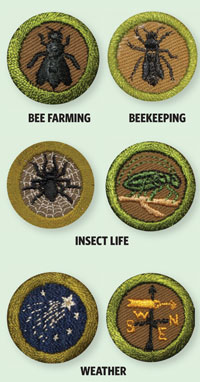 Bugs in the System
Bugs in the System
Quick question: How many legs does a bee have?
If you found yourself hesitating before saying “six,” you can empathize with the folks who designed the Bee Farming merit badge back in 1914. As you can see, the Scout Bee was a couple of legs short and stayed that way until 1939, when the correct version was designed for the now-discontinued Beekeeping merit badge.
Want more? For two years (1923-1925), the Insect Life badge featured a spider. But a spider is not an insect; it’s an arachnid, which has eight legs and two body parts rather than the insect’s six legs and three body parts.
When the Weather badge debuted in 1927, it showed a comet streaking across the night sky. But comets are not a weather-related phenomenon, so the weathervane replaced the comet.